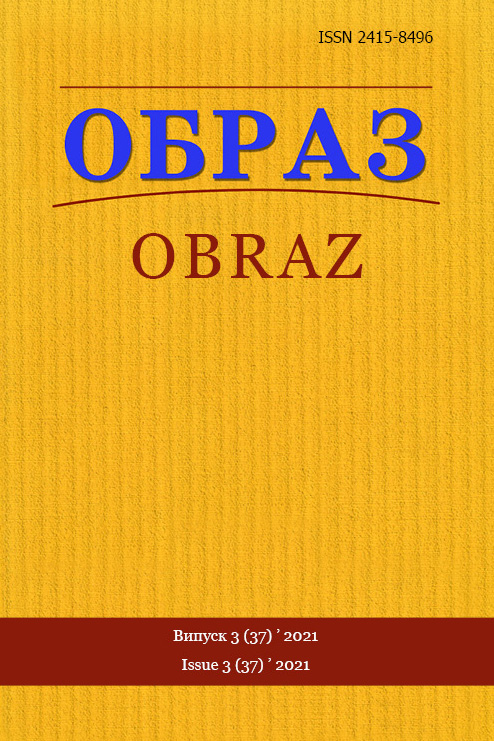Abstract
Introduction. As a rule, news sources are identified in journalistic texts manually. However as far as journalists use typical wordings for news sources references, it’s possible to create regular expressions and to design a computer program for automatic identification of the data. Relevance of the study. The program is important for news sources usage study in the digital reality, in particularly of ‘access hierarchy’ and ‘information hegemony’ defining. It may be additionally significant for some practical tasks achieving: news monitoring, professional standards compliance analysis. Research objective is to observe news sources exploiting in the regional mass media with computer analysis, define leading people sources and evaluate balance of the news. Methodology. Two local news sites were chosen for the analysis: Dymskaya and Odesa Life. At first a sample of texts was formed and regular expressions for the program were tested. References to the quotes, ‘communicative’ verbs and other expressions were coded. Content analysis was used, news sources were difened as elements of the analysis. Results. The program and manual processing results comparison shown an insignificant percent of mistakes (7,8% and 11% respectively). The reasons of the program’s mistakes were: incorrect identification of the news sources in analytics, blogs and columns, included in news feeds; larger vocabulary of the communicative verbs vocabulary; double references. In some cases the program shown pronouns and nouns (not just surnames). The latter problem may be solved with the list of spot words implementing. With the help of the program the leading news sources of Dumskaya site were defined: own correspondent, the president of Ukraine, the prime minister and other officials. All-Ukrainian news sources prevailed, while local authorities, activists, experts were not so popular. In the case of Odesa Life there was more balanced approach: local authorities and activists were represented. Conclusions. Thus, it’s quite possible to design the automatic approach to news sources study. The computer program was proposed and tested for this aim. In the majority of cases the program’s mistakes may be explained with the professional standards violation by the journalists (lack of accuracy in the references, analytics and columns placement in the news feeds etc). The limitations of the program: the need of resetting for every new site, because of some stylistic peculiarities and editorial policy. The analysis has shown the level of balance in the regional mass media: the texts form independent media outlet were more balanced.
References
1. Vasina, O. (2015), «Who owns Odesa mass media. Institute of Mass Information Analysis», Mediasapience [Media sapiens], available at: https://ms.detector.media/mediaanalitika/ post/14936/2015-11-24-komu-nalezhat-odeski-zmi-analiz-instytutu-masovoi-informatsii/ (accessed: 28 June 2021).
2. Holovenko, V. (2019), «Informatioon influence system of identification on the Internettraffic», URL:/aztyy [in Ukrainian], (accessed: 28 June 2021).
3. IDPO, (2021), «Careful government, silent citizens and the professional standards of regional journalism. Analytic report for May 2021 (part 3)», Detector media [Media detector], available at: https://idpo.org.ua/reports/4136-dbajliva-vlada-movchazni-gromadyani-taprofesijni-standarti-regionalno%d1%97-zhurnalistiki-analitichnij-zvit-za-traven-2021-rokuchastina-3.html, (accessed: 28 June 2021).
4. Davies, N. (2011), Flat Earth News, Kyiv, Tempora, 2011, 548 p.
5. Dovzhenko, O. (2019), «Confessed, stated, promised: why is it important to select words in news», Medialab, available at: https://medialab.online/news/terevenyty/, (accessed: 28 June 2021).
6. Lull, D. (2002), Mass Media, communication, culture: global approach, Kyiv, K. I. S., 264 p.
7. Lande, D. & Darmokhval, O. (2013), «Operativity and reprints in network news sources», Pravova infornatyka [Legal informatics], vol. 1, no. 37, pp. 24–29.
8. Melnyk, V. & Stepochkina, I. (2018), «Sourcecs of harmful information identification in social networks», available at: https://ela.kpi.ua/bitstream/123456789/25295/1/S.118-121. pdf, (accessed: 28 June 2021).
9. IDPO, (2019), «Evaluation of content quality methodology in regional print and online media», available at: https://idpo.org.ua/wp-content/uploads/2021/methodology-2021.pdf, (accessed: 28 June 2021).
10. Petrenko, O. (2013), «Sources of information about parties and majoritarian deputies during pre-election campaign 2012 (on example of Luhansk inhabitants», Taras Shevchenko Luhansk national university Herald [Bulletin of Luhansk Taras Shevchenko National University], vol. 11, no. 1, pp. 88–100.
11. Sobolev, A. (2019), «Sources of unreliable information dissemination identification in global network Internet», Data Recording, Storage & Processing, vol. 21, no. 3, pp. 56–68.
12. Steblyna N. (2015), «Regional sites – for whom are they working», Detector media [Media detector], available at: https://detector.media/regionalna-presaonlain/article/165060/2015-07- 20-regionalni-sayty-dlya-kogo-i-na-kogo-pratsyuyut/, (accessed: 28 June 2021).
13. Steblyna, N. (2019), «Ukrainian political regime representation in news of online media «Ukrayins`ka Pravda»», Politychne zhyttya [Political Life], vol. 4, pp. 99–108.
14. Chabanenko, M. (2017), «Facebook and journalism of news agencies on the Internet (on the example of UNIAN site’s news)», Naukovi zapysky Instytutu zhurnalistyky [Scientific Notes of the Institute of Journalism], vol. 1, pp. 93–97.
15. Shakhovska, N., Noga, P., & Vovk, O. (2014), «Intellectual system of news annotation for news reliability evaluation», Modelyuvannya ta informacijni texnologiyi [Modeling and Information Technologies], vol. 72, pp. 119–123.
16. Atton, C. (2006), Alternative media, London, Sage, 185 p.
17. Bennett, W.L., Lawrence, R.G. Livingston, S. (2007), When the Press Fails, Political Power and the News Media from Iraq to Katrina, Chicago, Chicago Press, 251 p.
18. Editorial Guidelines, BBC, available at: https://www.bbc.co.uk/editorialguidelines/ guidelines.
19. Gibson, J. (2017), «A crisis of relevance. Columbia Journalism Review», available at: https://www.cjr.org/special_report/news-janine-gibson-newspapers-audience.php (accessed: 28 June 2021).
20. Mehler, A., Bao, Y., Li, X., Wang, Y., & Skiena, S. (2006), «Spatial analysis of news sources», IEEE Transactions on Visualization and Computer Graphics, no. 12, vol. 5, pp. 765-772.
21. van Dejk J.A., (2006), The Network Society. Social Aspects of New Media, London, Thousand Oaks, 2006, 292 p.

This work is licensed under a Creative Commons Attribution 4.0 International License.

